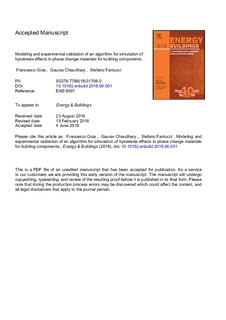| dc.contributor.author | Goia, Francesco | |
| dc.contributor.author | Chaudhary, Gaurav | |
| dc.contributor.author | Fantucci, Stefano | |
| dc.date.accessioned | 2018-07-10T08:25:13Z | |
| dc.date.available | 2018-07-10T08:25:13Z | |
| dc.date.created | 2018-07-03T10:07:47Z | |
| dc.date.issued | 2018 | |
| dc.identifier.citation | Energy and Buildings. 2018, 174 54-67. | nb_NO |
| dc.identifier.issn | 0378-7788 | |
| dc.identifier.uri | http://hdl.handle.net/11250/2504940 | |
| dc.description.abstract | The use of Phase Change Materials (PCM) in different building applications is a hot topic in today's R&D activities. Numerical simulations of PCM-based components are often used both for research activities and as a design tool, although present-day codes for building performance simulation (BPS) present some shortcomings that limit their reliability. One of these limitations is the limited possibility of replicating the effects given by thermal hysteresis – a characteristic of several PCMs.
In this paper, an original algorithm that allows hysteresis effects to be accounted for is described and the results from simulations are compared against experimental data. The algorithm is implemented in EnergyPlus™ and makes use of the Energy Management System (EMS) group, one of the high-level control methods available in EnergyPlus™. The algorithm enables the replication of PCM's different heating/cooling enthalpy curves in this BPS tool, which just recently was equipped with an integrated module for the replication of the effects of thermal hysteresis.
A comparison between numerical results from the proposed model and from other methods implemented in BPS tools, and the experimental data provided, shows the impact of the algorithm in the simulation of heat transfer in a PCM layer intent for opaque walls. In general, it is shown that the proposed method presents a better agreement with experimental data than alternative modelling approaches, but it is also seen that all the tested numerical models are not fully able to replicating the behaviour of PCM layers if the PCM does not melt or resolidify completely (i.e. it remains in the phase change) during the charge/discharge cycle. A local sensitivity analysis complements this study and highlights the most relevant parameters that influence the results of a simulation carried out with the proposed model.
Finally, the paper hypothesises that the general discrepancy between simulations and experimental data seen in the case of incomplete melting of the PCM layer can be due to unsuitable data for the thermophysical behaviour of the PCM, which are obtained through conventional characterisation procedures far from the physics of the PCM layer when in real building structures. | nb_NO |
| dc.language.iso | eng | nb_NO |
| dc.publisher | Elsevier | nb_NO |
| dc.rights | Attribution-NonCommercial-NoDerivatives 4.0 Internasjonal | * |
| dc.rights.uri | http://creativecommons.org/licenses/by-nc-nd/4.0/deed.no | * |
| dc.title | Modelling and experimental validation of an algorithm for simulation of hysteresis effects in phase change materials for building components | nb_NO |
| dc.type | Journal article | nb_NO |
| dc.type | Peer reviewed | nb_NO |
| dc.description.version | acceptedVersion | nb_NO |
| dc.source.pagenumber | 54-67 | nb_NO |
| dc.source.volume | 174 | nb_NO |
| dc.source.journal | Energy and Buildings | nb_NO |
| dc.identifier.doi | 10.1016/j.enbuild.2018.06.001 | |
| dc.identifier.cristin | 1595351 | |
| dc.relation.project | Norges forskningsråd: 193830 | nb_NO |
| dc.description.localcode | © 2018. This is the authors’ accepted and refereed manuscript to the article. Locked until 18.6.2020 due to copyright restrictions. This manuscript version is made available under the CC-BY-NC-ND 4.0 license http://creativecommons.org/licenses/by-nc-nd/4.0/ | nb_NO |
| cristin.unitcode | 194,61,55,0 | |
| cristin.unitname | Institutt for arkitektur og teknologi | |
| cristin.ispublished | true | |
| cristin.fulltext | postprint | |
| cristin.qualitycode | 2 | |

